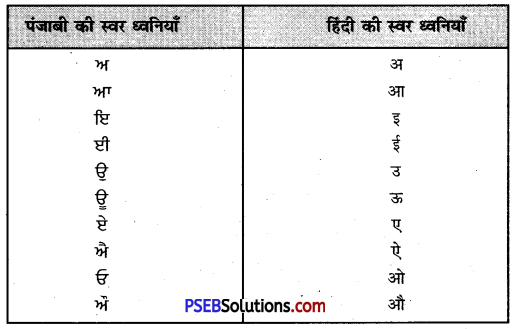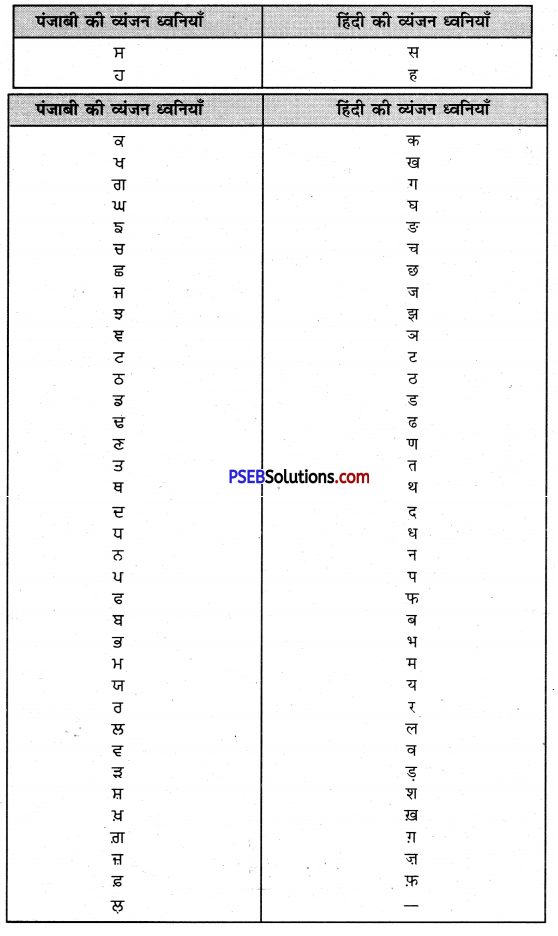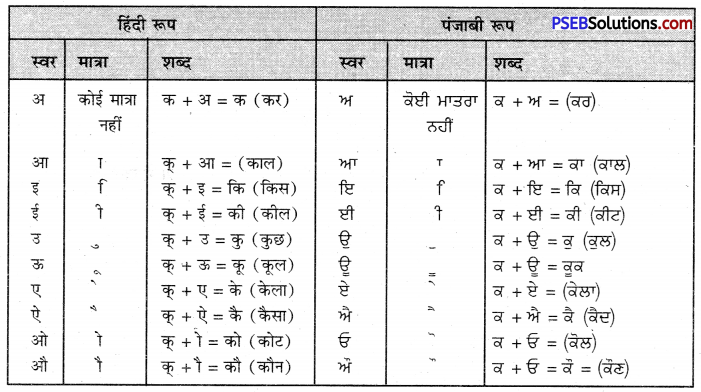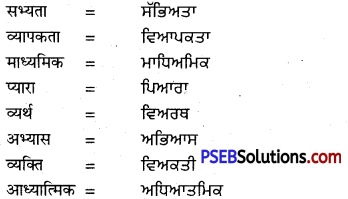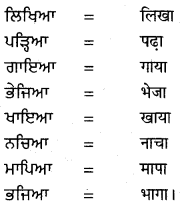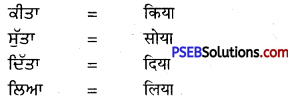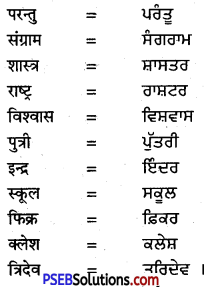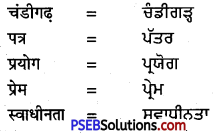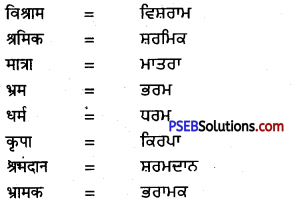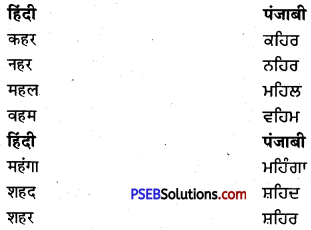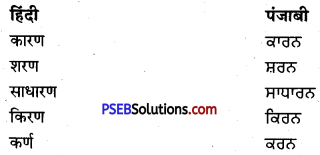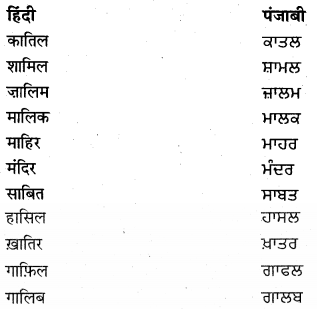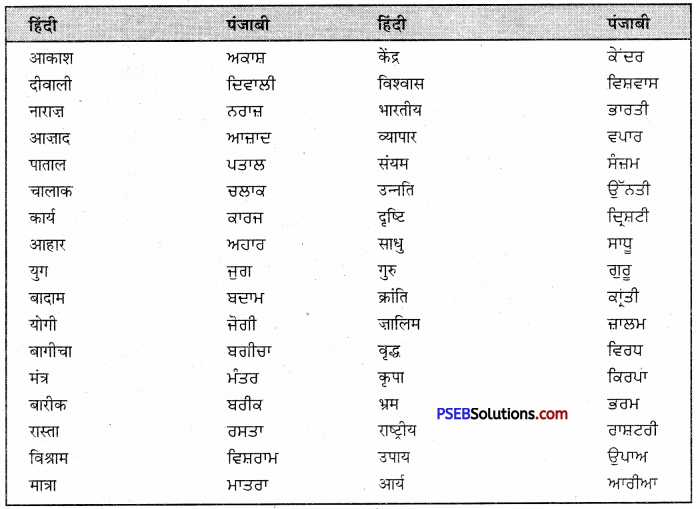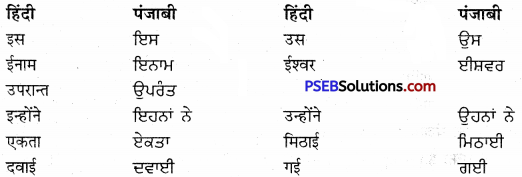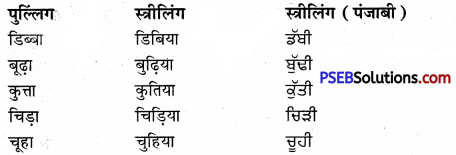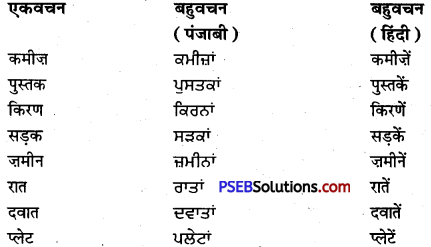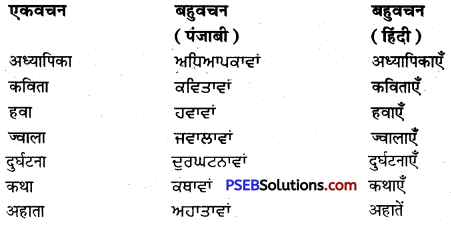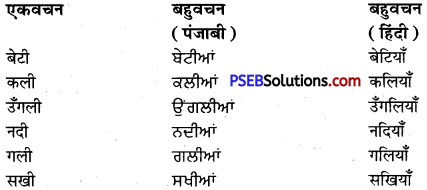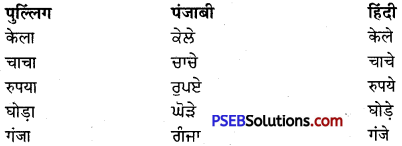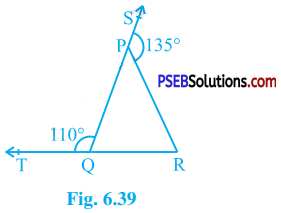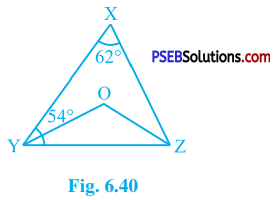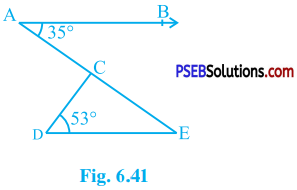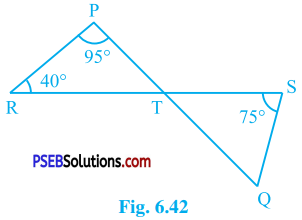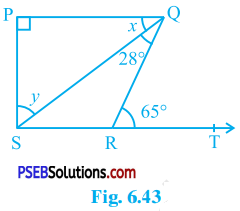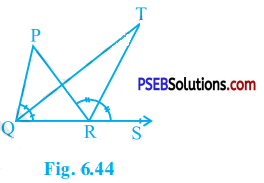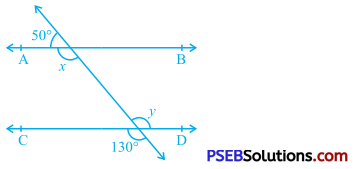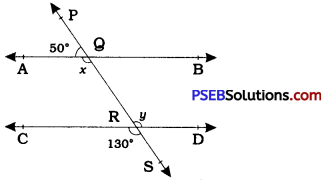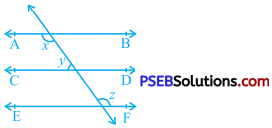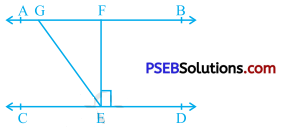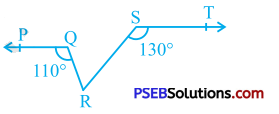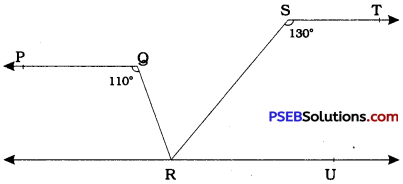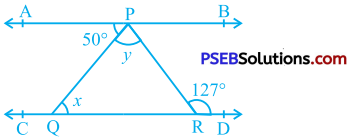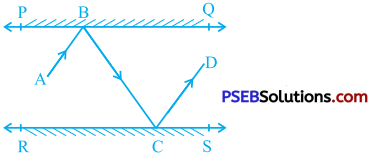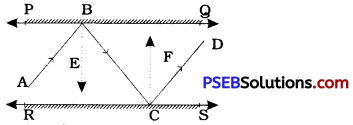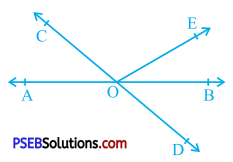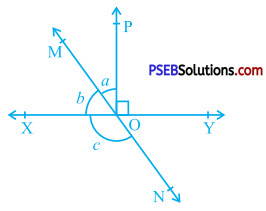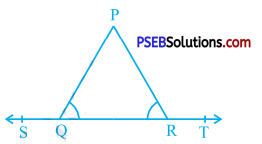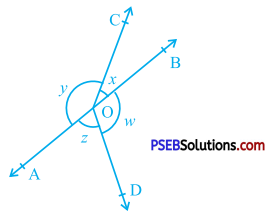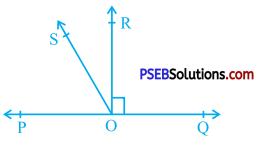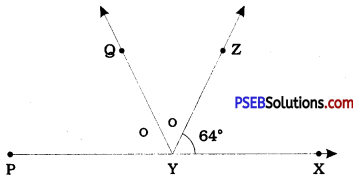Punjab State Board PSEB 9th Class English Book Solutions English Grammar Simple and Complex Sentences Exercise Questions and Answers, Notes.
PSEB 9th Class English Grammar Simple and Complex Sentences
Specify whether the following sentences are simple or complex :
1. God helps those who help themselves.
2. The teacher said that the earth moves around the sun.
3. The boy standing under the tree works very hard.
4. When it rains, we do not play.
5. The doctor advised the patient to give up drinking.
6. She went to the doctor because she had pain in her stomach.
7. She worked hard so that she should top the list.
8. There are seven days in a week.
9. All the good students in our school talk in English.
10. All the good teachers who teach us talk in Punjabi.
Answers
1. complex 2. complex 3. complex 4. complex 5. simple 6. complex 7. complex 8. simple 9. simple 10. complex.
![]()
Pick out the Noun Clause in each of the following sentences :
1. Please tell me where I can find good sweaters.
2. She hopes that she will pass this year.
3. You should understand why you failed last year.
4. He does not know what harm can come to him.
5. We do not know how she completed such a difficult job.
6. When the train will arrive is not certain.
7. I did not reply to what she said.
8. We visited her knowing that she had met with an accident.
9. I was very glad to get what I wanted.
10. The truth is that most people are after money.
Answer:
1. …………. where I can find good sweaters.
2. …….. that she will pass this year.
3. ………….. why you failed last year.
4. ………….. what harm can come to him.
5. ……. how she completed such a difficult job.
6. When the train will arrive …………..
7. …………. what she said.
8. …………….. that she had met with an accident.
9. …………………. what I wanted.
10. ………….. that most people are after money.
Pick out the Adjective Clause in each of the following sentences :
1. The girl whose father is a doctor lives here.
2. God helps those who help themselves.
3. The book I bought yesterday is missing.
4. This is the same story as my sister told me yesterday.
5. I have found the books which you lost yesterday.
6. Papa forgot to tell us the time when he would return.
7. This is the school where Raju got education.
8. Greed for money is a long road that has no end.
9. That was the film that I liked the most.
10. The hand that rocks the cradle rules the world.
Answer:
1. ………… whose father is a doctor…………..
2. ………………. those who help themselves.
3. …………… I bought yesterday ………………..
4. …………… as my sister told me yesterday.
5. …………… which you lost yesterday.
6. ………….. when he would return.
7. ………….. where Raju got education.
8. ……………. that has no end.
9. ………………… that I liked the most.
10. …………. that rocks the cradle ………
A Pick out the Adverb Clause in each of the following sentences :
1. The tighter the belt, the smarter the person.
2. In case it rains, we shall play indoor games.
3. He woke up early so that he could catch the train.
4. I will join a college even if my parents are against it.
5. Look before you leap.
6. There is no need to worry as long as you are working hard.
7. As time went by, he saved a lot of money.
8. He reached the station after the train had left.
9. I’ll put it where no one will see it.
10. I met him as he was coming from college.
Answers
1. The tighter the belt ………….
2. In case it rains …………..
3…………… so that he could catch the train.
4. …………. even if my parents are against it.
5. …………………….. before you leap.
6. …………… as long as you are working hard.
7. As time went by …………..
8. after the train had left.
9. …………. where no one will see it.
10. ………….. as he was coming from college.
![]()
Combine the following sentences, using an Adverb Clause in each case :
1. He injured himself. He was alighting from the bus. (use as’ or ‘while)
2. The platform became quiet. The train had left. (use ‘when’ or ‘after)
3. Arrange these books. I have shown you. (use ‘as)
4. I was very upset. I felt like crying. (use ‘so + adj + that)
5. Your brother is tall. My brother is taller. (use ‘than)
6. You finish the work early. We can play tennis. (use (if)
7. It was raining cats and dogs. They were playing football. (use ‘although)
8. Mohan should start very early. It will be better. (use the earlier, the better)
9. My brother could not do homework. There was no power last night.. (use “because)
10. She dances extremely well. You cannot help clapping. (use so…that)
Answer:
1. He injured himself while he was alighting from the bus.
2. The platform became quiet after the train had left.
3. Arrange these books as I have shown you.
4. I was so upset that I felt like crying.
5. My brother is taller than your brother.
6. If you finish the work early, we can play tennis.
7. Although it was raining cats and dogs, they were playing football.
8. The earlier Mohan starts, the better it will be.
9. My brother could not do homework because there was no power last night.
10. She dances so well that you cannot help clapping.
Transform the following sentences into complex ones without changing the meaning :
1. I don’t know his house. (use ‘where’)
2. She said something and I could not hear it. (use ‘what)
3. Some people help themselves and God helps them. (use ‘who)
4. The boy is very intelligent and his father is a doctor. (use ‘whose)
5. This box is too heavy for me to lift. (use ‘so …. that)
6. I wish to be rich. (use ‘were)
7. My father went to my school to meet my headmaster. (use so that)
8. Taking off his coat, Simran jumped into the canal. (use ,after)
9. Mohan is old but strong. (use ‘although)
10. A parentless child is called an orphan. (use ‘who)
Answer:
1. I don’t know where his house is.
2. I could not hear what she said.
3. God helps those who help themselves.
4. The boy whose father is a doctor is very intelligent.
5. This box is so heavy that I cannot lift it.
6. I wish that I were rich.
7. My father went to my school so that he could meet my headmaster.
8. Simran jumped into the canal after he had taken off his coat.
9. Although Mohan is old, he is strong.
10. A child who is parentless is called an orphan.
![]()
Transform the following into simple sentences :
1. He promised that he would return the money soon.
2. That Mohan will win the race is certain.
3. She did not tell us who helped her.
4. What is one man’s meat is another man’s poison.
5. She may accept the suggestion given by Surjeet.
6. The sum was so difficult that nobody was able to do it.
7. We selected this plan because it was easy.
8. This is the reason why he refused to help us.
9. He is studying hard because he wants to become a doctor.
10. A professor earns respect as he has a lot of knowledge.
Answer:
1. He promised to return the money soon.
2. Mohan will certainly win the race.
3. She did not tell us her helper’s name.
4. One man’s meat is another’s poison.
5. She may accept Surjeet’s suggestion.
6. The sum was too difficult for anybody to do.
7. We selected this plan for its being easy.
8. He refused to help us for this reason.
9. He is studying hard to become a doctor.
10. A professor earns respect due to his great knowledge.
Pick out the Noun Clauses from the following sentences :
1. That he is dead is true.
2. None knows where he lives.
3. That he will soon be killed is certain.
4. He promised that he would return the book after use.
5. I do not know when he left the place.
6. This is exactly what I expect of you.
7. He little knows what harm can come to him.
8. Nobody knows who did this mischief.
9. I wonder why there is a strike today.
10. The problem is how the refugees can be helped.
Answer:
1. That he is dead …………………
2…………………. where he lives.
3. That he will soon be killed …………….
4. ………………. that he would return the book after use.
5. ………………. when he left the place.
6. ………………… what I expect of you.
7. ………………. what harm can come to him.
8. ………………. who did this mischief.
9. …………… why there is a strike today.
10. ………. how the refugees can be helped.
![]()
Pick out the Adjective Clauses from the following sentences:
1. He killed the snake that bit his wife.
2. We may accept the offer he has made.
3. This is the garden in which we used to play.
4. I know the boy whose books were stolen yesterday.
5. I remember the house where I was born.
6. Youth is the time when seeds of character are sown.
7. Please tell me the story that everybody has liked so much.
8. There was not a man but laughed.
9. The place where he was born is still unknown.
10. The boy who stole the watch was caught.
Answer:
1. …………….. that bit his wife.
2. ………………… he has made.
3. ………………… in which. we used to play.
4. ……………… whose books were stolen yesterday.
5. ………………. where I was born.
6. …………… when seeds of character are sown.
7. ………………… that everybody has liked so much.
8. …………………… but laughed.
9. …………………….. where he was born ………
10. ……………….. who stole the watch ……….
Pick out the Adverbial Clauses from the following sentences :
1. He went home as soon as the school closed.
2. The boys work while the teacher is in the room.
3. You may come whenever you please.
4. She talks as if she were mad.
5. As far as I know, he is quite honest.
6. I could not come yesterday because I was ill.
7. I shall go out for a walk even if it rains.
8. After the play ended, we sang the national anthem.
9. Grapes won’t grow where there is heavy rainfall.
10. She is as pretty as a doll.
Answer:
1. ………………. as soon as the school closed.
2. ………………… while the teacher is in the room.
3. ……………….. whenever you please.
4. …………….. as if she were mad.
5. As far as I know ………..
6. …………….. because I was ill.
7. ………………… even if it rains.
8. After the play ended ………………..
9. ………………… where there is heavy rainfall.
10. ……………….. as pretty as ……….
![]()
Sentence :
शब्दों के किसी ऐसे समूह को वाक्य (Sentence) कहा जाता है जो अर्थ को पूर्ण रूप से स्पष्ट करता हो; जैसे :
- Boys are going to school.
- He went home yesterday.
- He is my best friend.
- God helps those who help themselves.
ऊपर दिया गया प्रत्येक शब्द-समूह किसी पूर्ण अर्थ को स्पष्ट करता है। इस प्रकार के शब्द-समूह को ही वाक्य (Sentence) कहा जाता है।
Phrase :
शब्दों के किसी ऐसे समूह को वाक्यांश (Phrase) कहा जाता है जिससे कुछ अर्थ तो निकलता हो किन्तु पूर्ण अर्थ न स्पष्ट होता हो; जैसे :
- in the morning.
- after an hour.
- on the table.
- with my brother.
Clause : ऐसे शब्द समूह को Clause (उप-वाक्य अथवा पद) कहा जाता है जो किसी पूर्ण वाक्य का अंश हो तथा जिसका अपना अलग Subject और Predicate हो। Clause के विचार से वाक्य तीन प्रकार के होते हैं :
1. Simple Sentence (सरल वाक्य)
2. Compound Sentence (संयुक्त वाक्य)
3. Complex Sentence (मिश्रित वाक्य)
1. Simple Sentence (सरल वाक्य)-जिस वाक्य की केवल एक ही Clause हो उसे Simple Sentence कहा जाता है; जैसे :
- The boy broke his leg.
- She washed her clothes.
- Mohan stood first in his class.
- I wrote a letter to my father.
2. Compound Sentence (संयुक्त वाक्य)-जिस वाक्य में दो या दो से अधिक अनाश्रित Clauses हों,
उसे Compound Sentence कहा जाता है, उदाहरण के रूप में
- Sita saw Rama and she became happy.
- You must work hard or you will fail.
- Many were called, but few were chosen.
- The sun rose and the fog disappeared.
![]()
Compound Sentence की प्रत्येक Clause को Co-ordinate clause कहा जाता है।
Complex Sentence (मिश्रित वाक्य)-जिस वाक्य में एक मुख्य-वाक्य (Principal Clause) हो तथा
एक या एक से अधिक आश्रित वाक्य (Subordinate Clauses) हों, उसे Complex Sentence कहा जाता
- Principal Clause को Main Clause भी कहा जाता है।
- Subordinate Clause को Dependent Clause भी कहा जाता है।

1. Principal Clause-मिश्रित वाक्य का वह खण्ड जो मुख्य Subject और मुख्य Predicare से बनता है,
उसे Principal Clause कहा जाता है।
2. Subordinate Clause-मिश्रित वाक्य का वह खण्ड है जिसका अर्थ Principal Clause पर आश्रित हो,
उसे Subordinate Clause कहा जाता है।
निम्नलिखित तालिकाओं में दिये गए Complex Sentences का अध्ययन कीजिए :
| Principal Clause | Subordinate Clause | |
| 1. | He lost the book | that I had given him. |
| 2. | I like the boys | who work hard. |
| 3. | I went to the place | where I had lost my purse. , |
| 4. | I want to know | he has passed. |
| Subordinate Clause | Principal Clause | |
| 1. | When the sunset | they returned home. |
| 2. | Unless you work hard | you can’t pass. |
| 3. | Where there is a will | there is a way. |
| 4. | Since you say so | I must believe it. |
Kinds Of Subordinate Clauses
Subordinate Clauses तीन प्रकार की होती है|
- Noun Clause
- Adjective Clause
- Adverb Clause
1. Noun Clause : किसी Complex Sentence में जो पद एक संज्ञा (Noun) का कार्य कर रहा हो, उसे ।
Noun Clause कहा जाता है। निम्नलिखित वाक्यों में तिरछे छपे हुए शब्द-समूह Noun Clause बनाते हैं :
1. That John was a thief was not known to me.
2. He was told that he must not be late again.
3. Learning that my brother had received serious injuries, I left for Shimla.
4. I was shocked to hear that his only son had died.
5. Listen to what the teacher says.
2. Adjective Clause :
किसी Complex Sentence में जो पद किसी विशेषण (Adjective) का कार्य कर रहा हो, उसे Adjective Clause कहा जाता है।
निम्नलिखित वाक्यों में तिरछे छपे हुए शब्द समूह
Adjective Clause बनाते हैं :
1. The company that supplied goods has failed.
2. The house where my brother lives has been sold.
3. The complaint which he made against me is false.
4. He is not such a man as can be trusted.
5. There was none but wept.
![]()
3. Adverb Clause : किसी Complex Sentence में जो पद किसी क्रिया विशेषण (Adverb) का कार्य कर रहा हो, उसे Adverb Clause कहा जाता है।
निम्नलिखित वाक्यों में तिरछे छपे हुए शब्द-समूह Adverb Clause बनाते हैं :
1. When the cat is away, the mice will play.
2. Where there is a will, there is a way.
3. You should act as the doctor advises you.
4. He talks as if he were mad.
5. As far as I know, Ram Lal is not to blame.
अब हम Complex Sentence के सम्बन्ध में प्रत्येक प्रकार की Clause का विस्तारपूर्वक अध्ययन करेंगे।
Noun Clause
Noun Clause—जिस उपवाक्य का प्रयोग प्रधान-वाक्य के किसी शब्द के साथ सम्बन्ध रखने वाली संज्ञा के रूप में किया जाये, उसे Noun Clause कहा जाता है। यह संज्ञा निम्नलिखित अवस्थाओं में हो सकती हैं :
1. Subject to a Verb.
- How she reached there is a mystery.
- That Vinod was a thief was not known to me.
- Whether he did so is doubtful.
2. Object to a Verb.
- He was told that he must not be late again.
- He asked her how old she was.
- I always do whatever is right.
3. Object to a Participle.
- He went there thinking that he might be able to help him.
- Seeing that the child was drowning, I jumped into the canal.
- Fearing that he should be late, he ran all the way to the station.
4. Object to an Infinitive.
- I was shocked to hear that his only son had died.
- I want to know what you are doing here.
- He came to ask if I was going to school.
5. Object to a Preposition.
- Listen to what your teacher says.
- The horse will sell for what it costs.
- They were arguing about who should do it.
![]()
6. Complement to a Verb.
- The fact is that he knows nothing.
- We are what we think.
- It seems that he will be a great man one day.
नोट : be (is, am, are, was, were, been), seem, look, appear, become आदि Linking
Verbs के बाद प्रयुक्त होने वाले शब्द अथवा पद Complement कहलाते हैं।
7. In apposition to a Noun.
- They took a vow that they would die for their motherland.
- He fufilled his promise that he would help me.
- The rumour that war has broken out is not true.
8. In apposition to the Pronoun it.
- It is true that he is honest.
- See to it that the boy is not hurt.
- It is unfortunate that he has failed.
Adjective Clause
Adjective Clause (विशेषण उपवाक्य) – जो उपवाक्य प्रधान-वाक्य के किसी शब्द के सम्बन्ध में विशेषण का काम कर रहा हो, उसे Adjective Clause कहा जाता है।
Adjective Clause दो अवस्थाओं में हो सकती हैः
1. Qualifying a Noun.
- The company that supplied the goods has failed.
- The house where your brother lived has been sold.
- The complaint he made against me is false.
2. Qualifying a Pronoun.
- There was none but wept.
- He that climbs too high is liable to fall.
- All that glitters is not gold.
Adjective Clause
(1) Adjective clause को Principal clause के साथ जोड़ने के लिए प्रायः निम्नलिखित sentence linkers का प्रयोग किया जाता है :
(a) Relative Pronouns : Who, whom, whose (+noun), that, which, as, but.
- The boys who are playing there are my students.
- He is the man whom I gave my book.
- She is the girl whose book was stolen.
- You can take the pen which you like.
- He has cut down the tree that grew in your field.
- Nothing but hard work pays in the long run.
![]()
(b) Relative Adverbs : When, where, why.
- We saw the house where he was born.
- He met me on the day when I was leaving for Mumbai.
- I told her the reason why she had failed.
(2) Who, whom तथा whose का प्रयोग मनुष्य जाति के लिए किया जाता है; जैसे : –
- He who works hard will succeed.
- She is the girl whom I gave my books.
- There stands the boy whose purse has been stolen.
(3) Whose का प्रयोग कई बार निर्जीव वस्तुओं के लिए भी कर लिया जाता है; जैसे :
- Draw a triangle whose sides are equal.
- This is the house whose owner has died.
(4) Which का प्रयोग जानवरों और निर्जीव वस्तुओं के लिए किया जाता है; जैसे :
- The dog which bit him has been killed.
- This is the watch which I wanted to buy.
(5) That का प्रयोग मनुष्य-जाति के लिए, जानवरों के लिए और निर्जीव वस्तुओं के लिए भी किया जा सकता है; जैसे :
- Happy is the man that (=who) is honest.
- This is the house that (=which) I wanted to buy.
- The man that (whom) we were looking for has arrived.
![]()
नोट : किन्तु यह बात ध्यान रखने योग्य है कि that का प्रयोग whose, of which, in which, to whom आदि के स्थान पर नहीं किया जा सकता। यदि Relative Pronoun से पूर्व-स्थित संज्ञा बिना बताए ही स्पष्ट (understood) हो और वह नपुंसक लिंग की हो, तो Relative Pronoun के रूप में which की बजाए what का प्रयोग किया जाता है ; जैसे :
- I cannot tell you what has happened. [what = the thing which]
- I have brought what he wanted. [what = the thing(s) which]
(6) As का प्रयोग Relative Pronoun के रूप में किया जा सकता है लेकिन इससे पूर्व ‘such’, ‘as’ अथवा the same’ अवश्य लगा होना चाहिए।
- This is not such a good book as I expected.
- You may ask as many questions as you like.
- Yours is not the same book as mine.
नोट :
(i) the same’ के बाद as का प्रयोग उस हालत में किया जाता है जब as के बाद लगने वाली क्रिया बिना बताए ही स्पष्ट (understood) हो।
This is not the same book as mine (is).
(ii) the same’ के बाद that का प्रयोग उस हालत में किया जाता है जब that वाले उपवाक्य में अपनी अलग क्रिया का प्रयोग किया जाना जरूरी हो।
This is the same book that you saw yesterday.
(7) But का प्रयोग ‘who not’ अथवा ‘which not’ के अर्थ में किया जा सकता है यदि यह उपवाक्य में Subject का काम कर रहा हो।
1. There was none but wept.
(There was none who did not weep).
2. There was no one present but saw the deed.
(There was no one present who did not see the deed).
3. There is no ailment so simple but may become serious in time.
(There is no ailment so simple which may not become serious in time).
(8) Objective case के रूप में प्रयुक्त होने वाले किसी Relative Pronoun को वाक्य में छोड़ा जा सकता है ; जैसे –
- I know all (that) you want to say.
- This is the same house (that) we lived in.
- The boy (whom) you teach is very clever.
- Have you seen the girl (whom) I sent to you?
- I have given him the book (that/which) he wanted.
किन्तु यह बात ध्यान देने योग्य है कि Relative Pronoun के प्रयोग को केवल तभी छोड़ सकते हैं जब यह Objective case में हो।
यदि यह कर्ता की स्थिति (Nominative case) में हो, तो इसका प्रयोग करना ही पड़ता है।
उदाहरण के रूप में हम कह सकते हैं कि
I employed the man who came yesterday.
किन्तु हम यह नहीं कह सकते कि
I employed the man came yesterday.
![]()
(9) यदि किसी Adjective clause के आरम्भ में Relative Pronoun के साथ कोई Preposition लगा हो,
तो उस Preposition का प्रयोग clause के अन्त में किया जा सकता है; जैसे
1. I know the man to whom you were talking.
I know the man (who / that) you were talking to.
कोष्ठकों में दिए गए who / that को छोड़ा जा सकता है क्योंकि ये objective case में हैं।
2. The road by which we passed was very crowded.
The road (that / which) we passed by was very crowded.
Adverb Clause
Adverb Clause (क्रिया-विशेषण उपवाक्य)-जो उपवाक्य प्रधान-वाक्य के किसी शब्द के सम्बन्ध में क्रिया-विशेषण का काम कर रहा हो, उसे Adverb Clause कहा जाता है। यह विशेषता निम्नलिखित सम्बन्धों में हो सकती है
1. Showing Time.
- When the cat is away, the mice will play.
- Wait here till I return.
- As soon as she saw her father, she began to cry.
2. Showing Place.
- I went where he led me.
- You can go wherever you like.
- Where there is a will, there is a way.
3. Showing Purpose.
- People work so that they may earn a living.
- He died in order that freedom might live.
- He ran fast lest he should miss the train.
4. Showing Reason.
- He is unable to attend school because he is ill.
- I cannot see you as I am not keeping well.
- Since you are over fourteen, you will have to pay full fare.
![]()
5. Showing Condition.
- If you work hard, you will succeed.
- I will not go there unless you accompany me.
- In case you come to me, I will help you.
6. Showing Result (or Effect).
- It was so dark that we could hardly see a foot before us.
- He is so weak that he cannot move about.
- He is such a dull boy that he cannot understand it.
7. Showing Comparison.
- He is as intelligent as his brother.
- You are stronger than I am.
- I can run faster than you.
8. Showing Contrast.
- Although he is poor, he is honest.
- The teacher gave him pass marks, though he deserved less.
- Weak as he is, he does his duty.
9. Showing Manner.
- You should follow me as I follow him.
- He ran as if he were mad.
- You should act as the doctor advises.
![]()
10. Showing Extent.
- So far as I know, he had left the place.
- The more you have, the more you want.
- The higher you go, the cooler it is.



